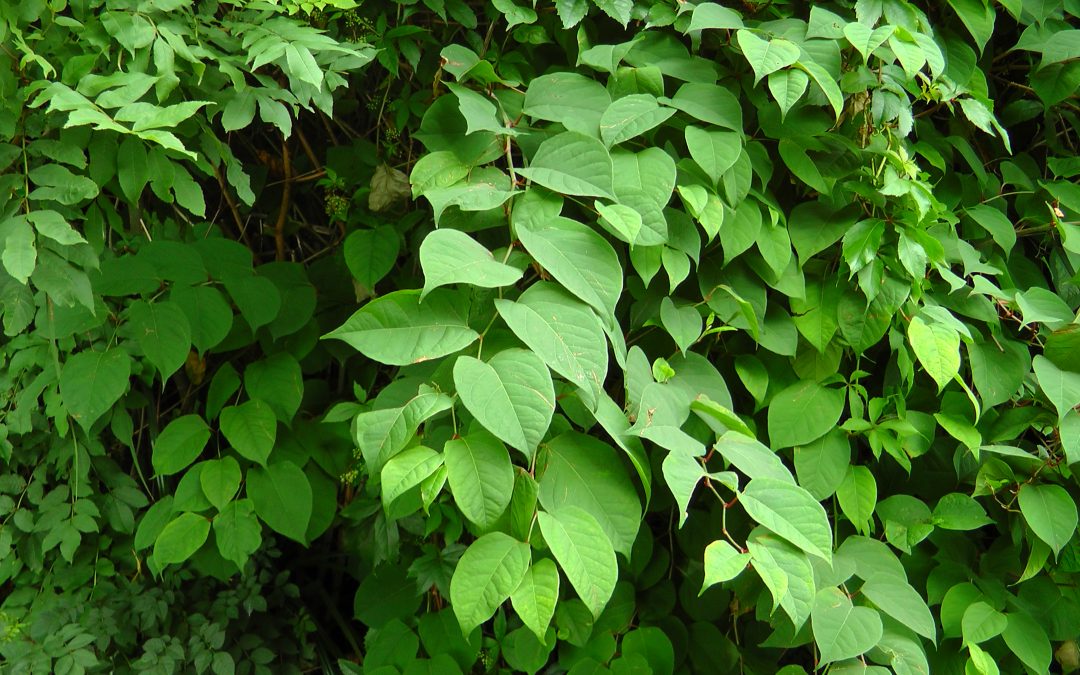What is Japanese knotweed? A Comprehensive Guide to Understanding this Invasive Plant
Japanese Knotweed is an intrusive plant species.
It has been causing problems for homeowners, landscapers, and councils across the United Kingdom and Europe. It is a perennial plant that can grow up to 10 feet tall and spreads aggressively. Quickly overtaking native plants and damaging structures in their path.
In this article, we will provide you with a comprehensive guide to understanding Japanese Knotweed. Including its origins, appearance, growth habits, and the best methods for controlling its spread.
Origins of Japanese Knotweed
Japanese Knotweed, also known as Fallopia Japonica, was first introduced to Europe in the 1800s as an ornamental plant. It quickly spread throughout the continent. It was used for erosion control and landscaping purposes. However, it was soon discovered that the plant’s aggressive growth habit. Also, its ability to spread quickly through underground rhizomes made it a nuisance. Today, it is considered one of the most invasive plant species in the world and is found in many parts of the United States and Europe.
Japanese knotweed mainly reproduces vegetatively for its life cycle.
Seeds from Japanese knotweed are generally considered non-viable because they are sterile or have a very low rate of germination. This is because Japanese knotweed is primarily spread through vegetative reproduction. Small pieces of the plant’s stem or rhizome (underground stem) can grow into new plants. As a result, the plant has evolved to rely less on seed production and more on vegetative reproduction, This allows it to quickly and effectively colonize new areas.
While Japanese knotweed does produce seeds.
They are often small, infrequent, and unlikely to successfully germinate. Additionally, even if the seeds do germinate, the resulting plants are often weaker and less competitive than those produced through vegetative reproduction, which further limits their success.
Once established, Japanese knotweed grows rapidly during the spring and summer months. Often reaching heights of up to 3-4 meters (10-13 feet). The plant produces numerous bamboo-like stems with characteristic purple-speckled nodes and large, heart-shaped leaves.

Leaves of Japanese knotweed
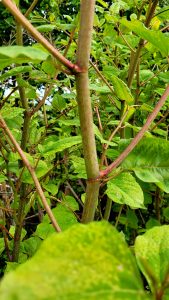
Stems of Japanese knotweed
The appearance of Japanese Knotweed in the spring,
new growth emerges from the crown of the plant, often from underground rhizome systems that can spread several meters in all directions. This new growth rapidly develops into tall stems and leaves. Marking the beginning of another growing season for Japanese knotweed.
In late summer and early autumn,
Japanese knotweed produces small, creamy-white flowers that are clustered together in upright panicles. These flowers are a valuable source of nectar for bees and other pollinators. The plant is typically considered a nuisance due to its aggressive growth and tendency to outcompete native plant species.
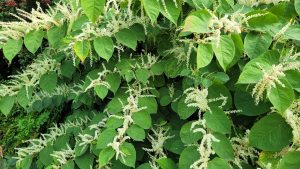
Japanese knotweed in full flower
As the autumn progresses,
the leaves of Japanese knotweed turn yellow and fall off. leaving behind thick, woody stems that persist through the winter months. These stems can provide shelter for wildlife such as birds and insects. But can also make the plant difficult to remove during the dormant season.
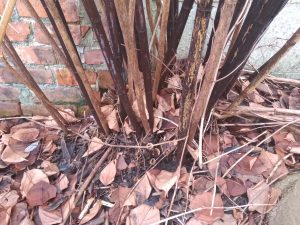
Winter appearance of Japanese Knotweed crown with the previous dead brown canes
Japanese Knotweed is a large, shrub-like plant that can grow up to 10 feet tall. It has hollow, bamboo-like stems that are usually green or red and are covered in small, purple-speckled nodes. The leaves are large and broad, typically 6-8 inches in length, and shaped like a heart. At the end of the summer, the leaves turn yellow before falling off. Japanese Knotweed also produces small, white, or cream-colored flowers in the late summer or early winter.
Growth Habits and Spread of Japanese Knotweed
- Japanese knotweed can often be found growing along railways and rivers. As well as in other areas of disturbance such as roadsides and abandoned lots. The plant has a deep and extensive root system that allows it to tolerate a wide range of soil types and moisture conditions.
Making it well-suited to colonizing areas with disrupted soil.
It is also tolerant of a wide range of temperatures and can grow in both sun and shade. Japanese Knotweed is a perennial plant that grows aggressively, spreading quickly through underground rhizomes that can travel up to 20 feet from the original plant. This makes it difficult to control, as even small fragments of the plant’s stem or root can produce new plants.
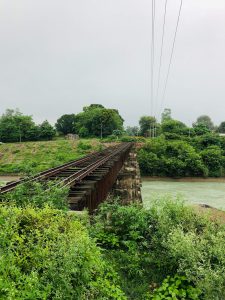
Railway and river
In the case of railways and rivers
Japanese knotweed can pose a particular problem, as it can cause damage to infrastructure such as tracks and bridges, as well as contribute to erosion along riverbanks. The plant can also spread rapidly along waterways, as fragments of its stem or root material can be carried downstream and develop into new plants.
As a result, many organizations responsible for managing railway and river networks in the UK have implemented measures to control and eradicate Japanese knotweed. Including chemical treatment, physical removal, and the use of barriers to prevent its spread.
It is important to note that the presence of Japanese knotweed along railways and rivers
can also have wider environmental impacts, as it can outcompete and displace native plant species. Leading to reduced biodiversity and habitat quality. Therefore, it is crucial to take action to prevent its spread and limit its impact on these sensitive ecosystems.
The plant is primarily spread through the dispersal of stem and root fragments.
They can be transported by water, wind, or human activity such as mowing or excavation. However, animals such as foxes or badgers that dig in the soil or disturb vegetation can inadvertently transport small pieces of rhizome material along with soil or plant debris.
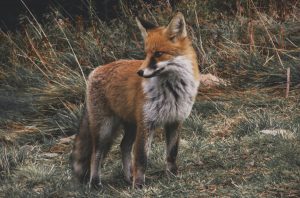
fox
While foxes may occasionally spread Japanese knotweed in this way, the risk is relatively low compared to other means of spread like fly-tipping. As a result, controlling the plant through chemical treatment remains the most effective way to prevent its spread and mitigate its impact.
Control of Japanese Knotweed
Controlling Japanese Knotweed can be a difficult task, as the plant is extremely hardy and can quickly grow back. There are several methods for controlling the spread of Japanese Knotweed, including chemical treatments, digging up the plant, and covering it with plastic or other materials. However, each of these methods has its advantages and disadvantages, and it is important to carefully consider the best approach for your specific situation.
Chemical treatment
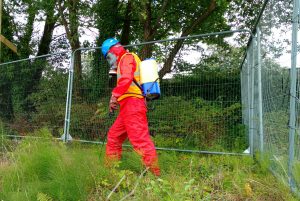
treating Japanese knotweed
Chemical treatments are one of the most effective ways to control Japanese Knotweed. But they can also be harmful to other plants and animals in the area.
Glyphosate is a common herbicide
It should be used carefully and only by professionals with experience in its application. Digging up the plant can also be effective, but it is time-consuming and must be done carefully to avoid spreading the plant further. Covering the plant with plastic or other materials can help to prevent its spread, but it must be done carefully and continue to be effective.
Japanese knotweed is a highly invasive and destructive plant that has become a significant problem over the past few decades. It is native to Japan and was first introduced to the UK in the mid-19th century as an ornamental plant. However, its aggressive growth and ability to quickly spread have led to it becoming a serious threat to the UK’s biodiversity and infrastructure.
The plant forms dense thickets that can smother other vegetation, including native species.
Its deep and extensive root system can penetrate gaps in foundations, walls, and other structures, leading to costly repair work. As a result, Japanese knotweed has been classified as one of the most problematic invasive species in the UK, and its eradication is a priority for many local authorities and landowners.
According to recent estimates, Japanese knotweed infestations are now present in over 2% of all properties in the UK. With the potential to cause billions of pounds worth of damage to homes, businesses, and infrastructure. It is prevalent in urban areas, where it can often be found along railway lines, roadsides, and brownfield sites.
If you are selling your house and you have Japanese knotweed in your garden
It is important to take steps to address the issue and ensure that potential buyers are fully informed.
The TA6 form is also known as the Property Information Form. Is a standard document used in the process of buying and selling residential property in England and Wales? It is completed by the seller and provides important information about the property to the buyer.
Property Information Form
Moreover, the TA6 form covers a wide range of topics, including the property’s boundaries, any disputes, or rights of way. Additional includes planning and building regulations, and any guarantees or warranties that are in place. It also includes information about the property’s utilities, such as water, gas, and electricity. It also notes details about any service charges or ground rent that apply.
In addition to providing information about the property itself. The TA6 form also requires the seller to disclose any environmental issues that may affect the property, such as the presence of Japanese knotweed or other invasive species.
Completing the TA6 form
Is an important part of the home buying and selling process. It helps to ensure that both parties have a clear and accurate understanding of the property and any associated risks or issues.
The first step is to have a professional survey carried out by Japanese knotweed Plus. To assess the extent of the knotweed and determine the most appropriate course of action. This may involve a combination of chemical treatment, physical removal, and ongoing monitoring and maintenance.
Once you have a clear understanding of the situation.
It is important to disclose the presence of Japanese knotweed to any potential buyers. This can be done through a seller’s property information form or by including a clause in the sale contract. It details the presence of the plant and any actions taken to address it.
Failure to disclose the presence of Japanese knotweed can have serious legal and financial consequences.
So it is important to be transparent and upfront with any potential buyers.
Additionally, It is also worth noting that many mortgage lenders and insurers have strict policies regarding Japanese knotweed. They may require evidence of treatment and ongoing management before approving a Mortgage or providing coverage.
Moreover, dealing with Japanese knotweed can be a complex and time-consuming process. But taking proactive steps to address the issue can help ensure a smoother and more successful home sale.
A Japanese knotweed management plan is a document that outlines the steps that will be taken to control and manage Japanese knotweed on a property. It is typically developed by a qualified specialist, such as a surveyor like me. It provides a detailed roadmap for dealing with invasive plants.
Japanese knotweed management plan
The purpose of a Japanese knotweed management plan is to ensure that the plant is dealt with safely and effectively. Thus minimizing any potential risks or impacts on the environment. The plan will typically include a thorough survey of the property to determine the extent of the knotweed, as well as a detailed assessment of the potential risks and impacts of the plant.

Management plan
Based on this assessment, the management plan
will outline a range of strategies and techniques for controlling and managing Japanese knotweed. This will include chemical treatments, and ongoing monitoring and maintenance. The plan will also include specific details about the timing and frequency of treatments, as well as any necessary follow-up actions.
In addition to guiding the technical aspects of knotweed management. The plan may also include information about legal and regulatory requirements. As well as recommendations for ongoing monitoring and reporting.
Moreover, a Japanese knotweed management plan is an important tool for property owners and managers
Who is dealing with this invasive plant? By following the recommendations outlined in the plan, it is possible to control and manage knotweed in a safe, effective, and environmentally responsible manner.
